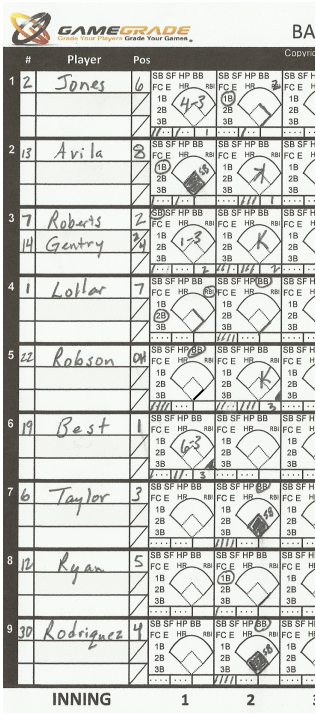The Art of Scoring Baseball/Softball
To a baseball coach, the lines and numbers and letters and circles and dashes…..well, you get the point, neatly written in the smallest of small boxes is a ‘Picasso’.
Scoring a baseball game truly is an art. What may look like chicken scratch or jibberish may be as valuable as gold to a coach or parent keeping stats.
Boxes averaging not much more than a square ½ inch can contain the unfolding of an epic comeback or an epic coming apart at the seams, all without a single word written.
Although many veteran scorers have their own, unique scoring techniques, I want to share the basics of getting the job done. I don’t know how many times I’ve posted a lineup card and had a player ask me what the #’s stood for. I think it’s an important part of a great game, so here goes:
Baseball uses a ‘Shorthand’ technique to make it relatively simple to keep a scorecard or scorebook during a game. Each position on the field is given a number and this number is used by coaches and scorers alike when turning in lineups, scorecards to umpires, scoring a game or grading games.
Positions by Numbers:
1- Pitcher
2- Catcher
3- First Base
4- Second Base
5- Third Base
6- Shortstop
7- Left Field
8- Center Field
9- Right Field
Positions by Letters:
P- Pitcher
C- Catcher
1B- First Base
2B- Second Base
3B- Third Base
SS- Shortstop
LF- Left Field
CF- Centerfield
RF- Right Field
Basic Outcome Abbreviations:
F- Fly
E- Error
K- Strikeout Swinging
![]() - Strikeout Looking
- Strikeout Looking
There are several statistics that begin with the letter "s," so newspaper editors decided that "k", which is the last letter of "Struck", as in "Struck out", would be best. This can be attributed to Henry Chadwick back in the 1850’s.
U- Unassisted (Meaning NO THROW was involved.)
1- Single
2- Double
3- Triple
HR- Homerun
SAC- Sacrifice Bunt/Hit
BB- Walk
HP- Hit By Pitch
FC- Fielder’s Choice
In the following example, let’s go through the 1st inning.
Jones leads off and is put out on a ground ball to the second baseman who throws it to the first baseman (4-3).
2-hole hitter Avila hits a single with a 1-1 count, steals second base, is sacrificed over to third and ends up scoring on Lollar’s double.
3-hole hitter Roberts sacrifice bunts and is thrown out at first base with a throw from the pitcher.
Also in this example you can see that Roberts was later replaced in the game (4th inning) at the catcher (2) position.
Clean-up (4-hole) hitter Lollar hits a run-scoring double earning him a trip to second base and an RBI.
5-hole hitter, Robson, walks and 6-hole hitter, Best, grounds out to the shortstop (6-3) to end the inning.

Also, in this example, you will note that a line is used each time a baserunner moves from base to base. And oft times the scorer will note what occured to enable the runner to move by either circling the available abbreviations or writing what happened ie. SB- The baserunner stole 2nd.
Another example could be a notation for a single with the runner moving to 2B on an error. In this instance, an E-7 would be written between first and second base showing the runner moving up a base because of the error.
Other notations could be:
WP- Wild Pitch
PB- Passed Ball
BALK
Finally, when a baserunner has moved around all bases and crossed homeplate, the Diamond is filled in, representing a Run Scored.
As you can see- Baseball has it’s own language. It’s own unique set of letters, symbols and terms makes it a game like no other. And what a great game it is!!
-GameGrade